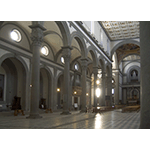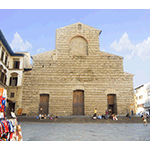Basilica of San Lorenzo
San Lorenzo is one of the most significant Renaissance churches in Florence; the story of its construction witnesses and testifies to the fortunate rise of the Medici family. The basilica stands on the site of one of the oldest churches in Florence which dates to the 4th century and was rebuilt on Romanesque canons in the 11th century. The first project to enlarge the Romanesque church dates to the second decade of the 15th century: it was commissioned from Filippo Brunelleschi by Giovanni de’ Medici, father of Cosimo the Elder and founder of the Medici dynasty. Work began in the area of the transept where a modern, raised choir was planned, along with square chapels in place of the old Romanesque apse. Brunelleschi’s more ambitious project to totally renew the building was put off and only realised in the second half of the 15th century, though with considerable modifications compared to the original concept. The basilica space was, in any event, organised according to the laws of geometry, while a well-calculated use of proportion joined all of the architectural elements, thus offering a significant example of the close relationship between science and art.
Between 1422 and 1428, Brunelleschi worked on the Medici burial ground thereafter called the Old Sacristy, which was the first accomplished cultural and artistic message of the early Renaissance: this was indeed the first construction in which, thanks also to reflection on classical art, architectural space was restored to a human scale. The cupola of the scarsella (small rectangular apse) in the Old Sacristy is painted with a fascinating astronomical image that exemplifies the close relationship between science and art. While the custom of decorating vaults with starry skies originated in Byzantine mosaics, the idea to scientifically represent the northern hemisphere in a little cupola inside a religious building was absolutely innovative and closely tied to the humanist intellectual climate. According to recent studies that have made it possible to date the astral conjunction depicted, though leaving the matter of its motive undetermined, this small planetarium, based on geocentric concepts of Ptolemaic origin, probably reproduces the sky of Florence in July 1442. The scientific importance of the fresco lies in the extreme precision with which the celestial bodies are positioned. The Moon, the Sun, Jupiter, Venus and the principal coordinates of the celestial sphere are evidenced in gold against the blue ground representing the sky, while the personifications of several constellations are outlined in black with white highlighting. The author most likely followed the suggestions of an astronomer who may have been Paolo dal Pozzo Toscanelli, a friend of Filippo Brunelleschi’s. It must be remembered, however, that the painting’s purpose was essentially astrological and commemorative, confirming the close tie between astronomy and astrology in Renaissance culture. A fresco with an analogous subject is found in the Pazzi Chapel next to the church of Santa Croce.
****************************
Texts by Graziano Magrini
English translation by Victor Beard
Last update 30/gen/2008





